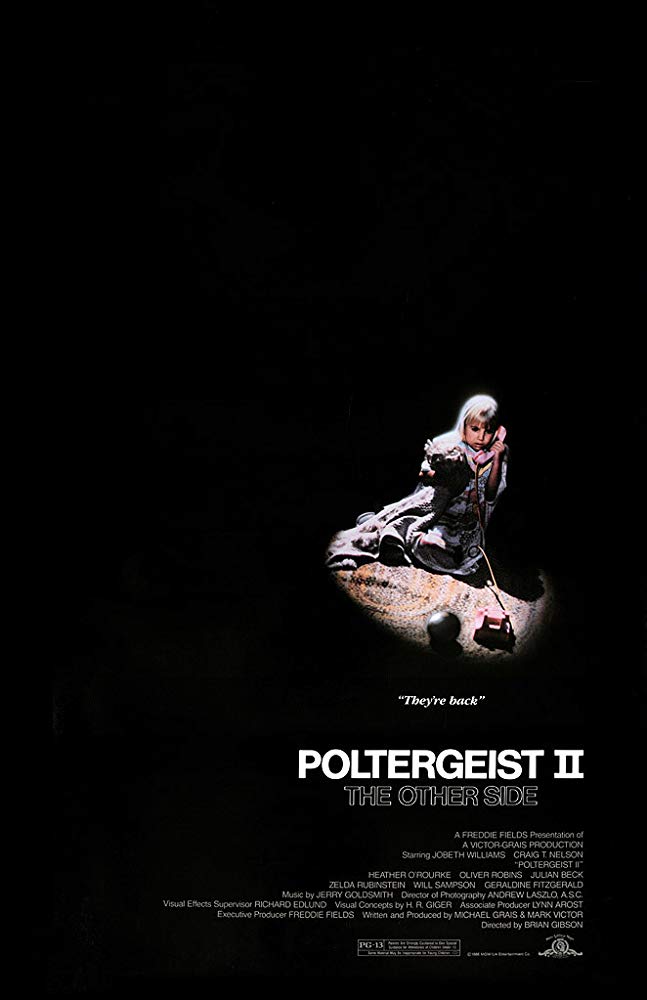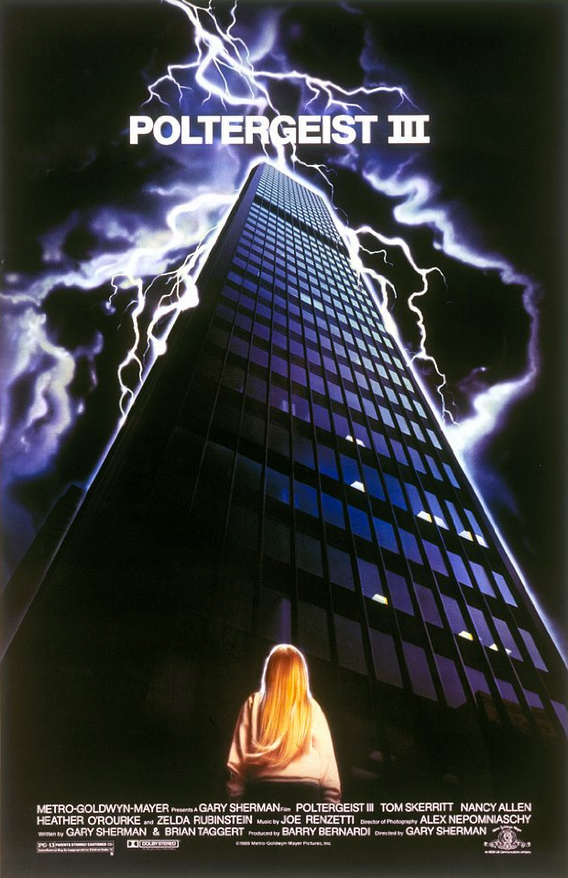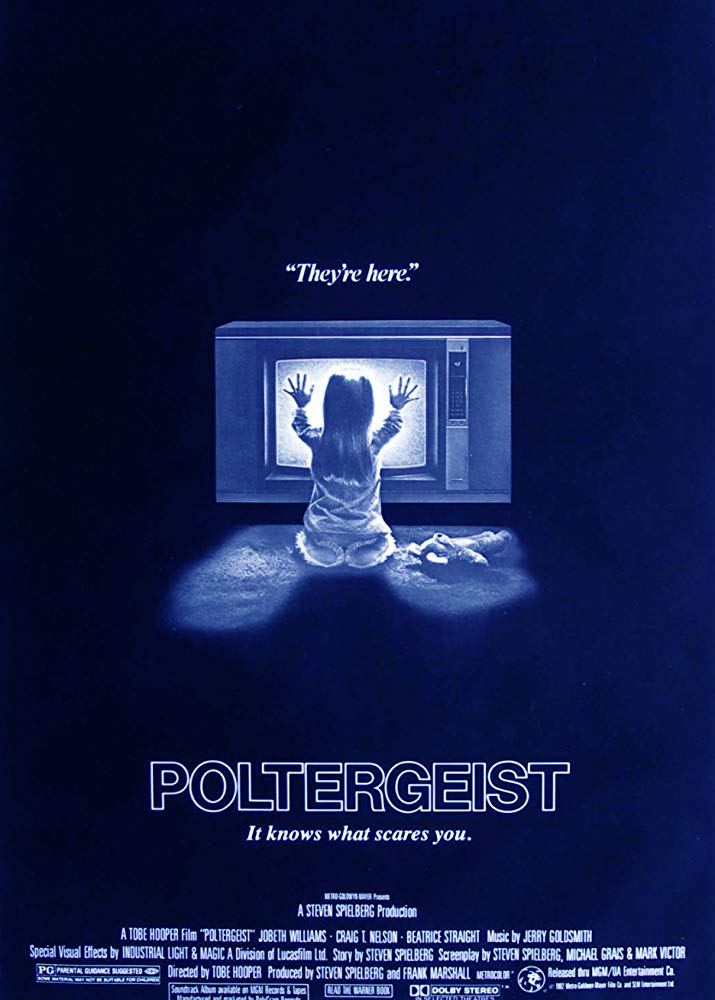While continuing the AMITYVILLE-era trend for mainstream paranormal movies, Tobe Hooper’s biggest Hollywood hit also reflected the various ways in which studio blockbusters aimed at family audiences embraced horror movie tropes and tricks. When the equally ghoulish and gruesome PG rated GREMLINS and INDIANA JONES AND THE TEMPLE OF DOOM confirmed the trend in 1984, the MPAA was forced to introduce its PG-13 rating to fight off parental complaints about content. Co-produced and co-written by Steven Spielberg, the movie is built around a very Spielbergian portrait of suburbia, where joshing neighbours have stand-offs over TV remote controls and loveable ex-hippy couple Craig T Nelson and Jobeth Williams are inadvertently raising their young kids (Oliver Robbins, Heather O’Rourke) and teenage daughter (Dominique Dunn) in a house built on an old Indian burial ground. When Carol-Anne (O’Rourke) goes missing within the house – taken by, in her words, “the TV people” – a memorable group of parapsychologists led by Oscar winner Beatrice Straight and eccentric midget Tangina (Zelda Rubinstein) have to figure out how to get her back.
This has a sentimental portrait of the afterlife, a lush, lavish Jerry Goldsmith score and some of the most impressive visual FX of the era, though it’s also among the wittiest of the 80’s Spielberg productions. The puncturing of the American family institution of television echoes the famous TWILIGHT ZONE episode “It’s A Good Life”. A knowing early scene features Mom switching the TV set over from the static that entrances Carol-Anne, noting “that’s bad for your eyes” and blissfully ignorant to the fact she’s now watching a brutish war movie. The portrait of TV as literally harmful to impressionable viewers during the home video revolution is balanced by the on-screen references to the big-screen Lucas-Spielberg canon, including STAR WARS and JAWS. The marriage of humour, heart and horror works remarkably well, with Hooper indulging his life-long love of EC Comics via grisly visuals of maggot-covered meat and a parapsychologist unforgettably tearing his face off in front of a bathroom mirror. The denouement captures some of the frenetic intensity of the director’s best work as corpses pop up from the floorboards and characters fall into a cadaver-infested swimming pool. Before it becomes a battle to decide whether Carol-Anne should be heading to, or away from, “The Light”, POLTERGEIST also delivers some of the most frightening Hollywood horror moments of the 80’s: a brilliantly realised encounter with a malevolent tree and a classic childhood nightmare featuring cinema’s creepiest toy clown, echoing the adolescent horrors of Hooper’s SALEM’S LOT.
POLTERGEIST II: THE OTHER SIDE *** USA 1986 Dir: Brian Gibson. 91 mins
 Minus Spielberg and Hooper, this lavish sequel (beautifully shot by Andrew Laszlo) strives to replicate and upstage the main beats of the popular original. It successfully resumes the domestic chemistry between the returning Freeling family members (Jobeth Williams, Craig T Nelson, Heather O’Rourke and Oliver Robbins), finding touching grace notes in between the set pieces: a moment of Carol-Anne talking about growing up gains an unintended resonance in the wake of O’Rourke’s premature death two years later. A prologue recaps the original’s climax, sets up a new character (Will Sampson’s medicine man) and brings back Tangina at the old graveyard upon which the Freelings’ property was constructed. One year on from POLTERGEIST, the family are living with Grandma (Geraldine Fitzgerald) and without a television. In a nice touch of mundane reality, they are also tackling insurance claims weakened by their “missing” house. Fitzgerald is Scatman Crothers to O’Rourke’s Danny Lloyd in their quiet, THE SHINING-inspired scenes sharing stories about a shared psychic “gift”, but Grandma’s subsequent death is accompanied by the emergence of a new threat. Julian Beck’s genuinely alarming, Jim Jones-inspired cult leader Reverend Kane, who tasted The Light during the retrieval of Carol-Anne from the other side, is described by Tangina as simply “The Beast”.
Minus Spielberg and Hooper, this lavish sequel (beautifully shot by Andrew Laszlo) strives to replicate and upstage the main beats of the popular original. It successfully resumes the domestic chemistry between the returning Freeling family members (Jobeth Williams, Craig T Nelson, Heather O’Rourke and Oliver Robbins), finding touching grace notes in between the set pieces: a moment of Carol-Anne talking about growing up gains an unintended resonance in the wake of O’Rourke’s premature death two years later. A prologue recaps the original’s climax, sets up a new character (Will Sampson’s medicine man) and brings back Tangina at the old graveyard upon which the Freelings’ property was constructed. One year on from POLTERGEIST, the family are living with Grandma (Geraldine Fitzgerald) and without a television. In a nice touch of mundane reality, they are also tackling insurance claims weakened by their “missing” house. Fitzgerald is Scatman Crothers to O’Rourke’s Danny Lloyd in their quiet, THE SHINING-inspired scenes sharing stories about a shared psychic “gift”, but Grandma’s subsequent death is accompanied by the emergence of a new threat. Julian Beck’s genuinely alarming, Jim Jones-inspired cult leader Reverend Kane, who tasted The Light during the retrieval of Carol-Anne from the other side, is described by Tangina as simply “The Beast”.Beck’s cadaverous Southern holy man (“God Is In His Holy Temple…”) still chills as he cleverly exploits the family’s natural weaknesses, including every parent’s fear about losing their child in a public place and the father’s insecurity about his own manliness / ability to provide for his family. In the sequel tradition, the film offers many call-backs to the original, from O’Rourke’s exclamation of “They’re back!” to a Tobe Hooper nod involving a flying chainsaw. Jerry Goldsmith returns with a dynamic score echoing his work on the OMEN trilogy via a marvellously malevolent choral theme for Reverend Kane. The best set pieces present elaborate visualisations of kids’ personalised nightmares, including Robbins’ dental brace taking on a life of its own and cuddly Dad Nelson transforming into a sweaty, unrepentant bully after swallowing an evil Tequila worm. He vomits up a fast-growing, part stop-motion beastie in a stand-out FX scene that plays out like a fabulously weird hybrid of the chestburster in ALIEN and Fulci’s CITY OF THE LIVING DEAD vomit-o-rama. There’s much to like about POLTERGEIST II, so it’s a shame that it peters out with a poorly realised family journey to “The Other Side” in which the formidable forces of evil are easily defeated courtesy of the green screen arrival of angelic dead Grandma. Since the film’s release, there has been much discussion about studio intervention following a significantly longer original cut – so we can portion at least some of the blame to this familiar Hollywood spectre.
POLTERGEIST III ** USA 1988 Dir: Gary Sherman. 97 mins
 Significant budget cuts and the absence of most of the original Freeling family suggested a franchise reaching its natural end, though this third instalment was clouded by the death in post-production of its returning star, 13-year-old Heather O’Rourke. As with POLTERGEIST II, talks of reshoots and studio interference have been blamed for its unsatisfying final form. Director Gary Sherman had a strong pedigree, debuting with one of the great modern British horror films (DEATHLINE) and graduating to the excellent DEAD AND BURIED. His desire for practical, in-camera effects (in contrast to the visual effects of the earlier films) became the movie’s strongest suit. Carol-Anne is sent to live with her aunt (Nancy Allen) and uncle (Tom Skerritt), with the suburban backdrop of the first two movies replaced with a luxury Chicago apartment building and scare set-ups in underground car parks and art galleries. The pre-pubescent incarnation of Carol-Anne is underwritten, and, with the death of Julian Beck, the returning Reverend Kane is played to far less disturbing effect by Nathan Davis. Shades of Stephen King accompany the scenes of Carol-Anne attending a school for “gifted” kids with emotional problems, where the resident psychiatrist (Richard Fire) is destined to suffer the only supernaturally-spawned death in the series by being a sneering cynic who dismisses the paranormal and suggests the girl has merely manipulated others into seeing sinister events.
Significant budget cuts and the absence of most of the original Freeling family suggested a franchise reaching its natural end, though this third instalment was clouded by the death in post-production of its returning star, 13-year-old Heather O’Rourke. As with POLTERGEIST II, talks of reshoots and studio interference have been blamed for its unsatisfying final form. Director Gary Sherman had a strong pedigree, debuting with one of the great modern British horror films (DEATHLINE) and graduating to the excellent DEAD AND BURIED. His desire for practical, in-camera effects (in contrast to the visual effects of the earlier films) became the movie’s strongest suit. Carol-Anne is sent to live with her aunt (Nancy Allen) and uncle (Tom Skerritt), with the suburban backdrop of the first two movies replaced with a luxury Chicago apartment building and scare set-ups in underground car parks and art galleries. The pre-pubescent incarnation of Carol-Anne is underwritten, and, with the death of Julian Beck, the returning Reverend Kane is played to far less disturbing effect by Nathan Davis. Shades of Stephen King accompany the scenes of Carol-Anne attending a school for “gifted” kids with emotional problems, where the resident psychiatrist (Richard Fire) is destined to suffer the only supernaturally-spawned death in the series by being a sneering cynic who dismisses the paranormal and suggests the girl has merely manipulated others into seeing sinister events.
It starts well with small moments of creeping dread involving cracks in the building’s glassy structure, a sense of evil invading reflective surfaces and eerie moments of characters leaving behind a malevolent reflection once they’ve left the room. The notion of malicious doppelgangers is, alas, botched in the final third. The dynamic between the bravely unsympathetic Allen (who compares Carol-Anne to Uri Gellar) and Skerritt (referring to Tangina and the doc as “Tweedledum and Tweedledee”) is well played, but too much time is spent with Skerritt’s teenage daughter (Lara Flynn Boyle) and her dull friends, while the return of Tangina – using the power of Will Sampson’s amulet from THE OTHER SIDE – proves contrived and tired. Despite having a higher MPAA-rating than the famously gruesome PG-rated original, it’s the tamest of the three movies in terms of scares and onscreen horror, descending into a listless final 20 minutes in which Tangina defeats Kane by yelling “I have the knowledge and the power!”
POLTERGEIST ** USA 2015 Dir: Gil Kenan. 93 mins
 Tobe Hooper’s 1982 POLTERGEIST was much imitated in the thirty years it took to get this remake off the ground, notably by the INSIDIOUS series, though the director of the impressive feature animation MONSTER HOUSE seemed a logical fit for the project. Sadly, it’s stolidly unimaginative, making minor tweaks to the original’s iconic moments (instead of a single, terrifying clown we have…a box of clowns!) and sticking closely to its basic structure. It opens with what appears to be TV static (an anachronism in a digital age where TV never closes down for the night), leading to a pull-out reveal of a horror game played by a 21st century kid on a tablet. Replacing the Freelings are an oddly unlikeable couple and their three kids: in a neat post-economic-crash twist, Dad (Sam Rockwell) is depressed and in debt, forced to move with his wife (Rosemarie DeWitt) into a “temporary” house in a neighbourhood beset by foreclosures. Madison, their youngest, disappears into an alternate dimension and, with the help of parapsychologists, they discover the house was build on an old cemetery – though this time a peripheral character references “some ancient tribal ground” as a throwaway joke. The nudge-nudge references to the original (“This house is clean” / a bumper sticker that reads “Hooper High”) are lame and the movie, although slick, feels under-nourished and unfinished. There’s no chemistry between the family members, with the very talented Rockwell peculiarly miscast in the role of an ordinary, struggling patriarch. Cheap scares (including a squirrel scare instead of the usual cat scare!) dominate, and its biggest innovation is the use of the kids’ drone to assist the remixed mission toward “The Light”. Perhaps its biggest misstep is the replacement of Tangina with a goofy television ghost hunter leading the investigations at the troubled house: Jared Harris, another good actor saddled with poor writing, is borderline embarrassing in this irritating role.
Tobe Hooper’s 1982 POLTERGEIST was much imitated in the thirty years it took to get this remake off the ground, notably by the INSIDIOUS series, though the director of the impressive feature animation MONSTER HOUSE seemed a logical fit for the project. Sadly, it’s stolidly unimaginative, making minor tweaks to the original’s iconic moments (instead of a single, terrifying clown we have…a box of clowns!) and sticking closely to its basic structure. It opens with what appears to be TV static (an anachronism in a digital age where TV never closes down for the night), leading to a pull-out reveal of a horror game played by a 21st century kid on a tablet. Replacing the Freelings are an oddly unlikeable couple and their three kids: in a neat post-economic-crash twist, Dad (Sam Rockwell) is depressed and in debt, forced to move with his wife (Rosemarie DeWitt) into a “temporary” house in a neighbourhood beset by foreclosures. Madison, their youngest, disappears into an alternate dimension and, with the help of parapsychologists, they discover the house was build on an old cemetery – though this time a peripheral character references “some ancient tribal ground” as a throwaway joke. The nudge-nudge references to the original (“This house is clean” / a bumper sticker that reads “Hooper High”) are lame and the movie, although slick, feels under-nourished and unfinished. There’s no chemistry between the family members, with the very talented Rockwell peculiarly miscast in the role of an ordinary, struggling patriarch. Cheap scares (including a squirrel scare instead of the usual cat scare!) dominate, and its biggest innovation is the use of the kids’ drone to assist the remixed mission toward “The Light”. Perhaps its biggest misstep is the replacement of Tangina with a goofy television ghost hunter leading the investigations at the troubled house: Jared Harris, another good actor saddled with poor writing, is borderline embarrassing in this irritating role.
Reviews by Steven West



